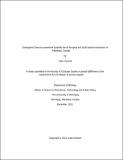| dc.contributor.author | Henault, Justis | |
| dc.date.accessioned | 2021-12-22T20:01:20Z | |
| dc.date.available | 2021-12-22T20:01:20Z | |
| dc.date.issued | 2021-10-29 | |
| dc.identifier.citation | Henault, Justis. Endangered Oarisma poweshiek butterfly larval foraging and adult habitat interactions in Manitoba, Canada; A thesis submitted to the Faculty of Graduate Studies in partial fulfillment of the requirements for the Master of Science degree. Department of Biology, Master of Science in Bioscience, Technology and Public Policy, The University of Winnipeg. Winnipeg, Manitoba, Canada: University of Winnipeg, December 2021. DOI: 10.36939/ir.202112221602. | en_US |
| dc.identifier.uri | https://hdl.handle.net/10680/1980 | |
| dc.description | This research was conducted on Treaty 1 territory, the ancestral home of Anishinaabe, Cree and Métis peoples and current home of diverse First Nations, Métis, Inuit and other Indigenous cultures. Thanks for your contributions to steward the ecosystem and creating the opportunity to research this wildlife! Thank you to members of the Manitoba Tall Grass Prairie Preserve Management Committee, for developing permits to conduct research. | en_US |
| dc.description.abstract | The Poweshiek skipperling (Oarisma poweshiek) is endemic to the tall grass prairie in North America, and is now critically endangered globally. Existing populations are scattered amongst tall grass prairie remnants. However, the host food plants eaten by Poweshiek skipperling larvae, the vegetative and microclimatic descriptions of immature and adult microhabitats as well as O. poweshiek behaviour in Manitoba are unknown. I observed the foraging behaviour of larval O. poweshiek in natural habitat to determine the plant species that they consume and document their development. I also followed adults in prairie patches to identify locations in which various activities, such as egg laying or nectar feeding, were facilitated by the habitat. I measured vegetative, structural and microclimatic attributes of microhabitats to determine potential characteristics which facilitate various adult activities and larval development. Larvae appeared to navigate microhabitats to locate host food plant species, alternating between shoots of various species throughout their development. Adults flew almost exclusively in the prairie plant community, rarely flew in shrub or ephemeral wetland communities and were never observed flying in wetland or forest communities. Adult activities appeared to be distributed along a soil moisture gradient, with egg laying associated with the mesic section of the moisture gradient, resting and/or basking associated with the drier section and nectar feeding generally associated with sections throughout the moisture gradient. My research contributes knowledge about larval O. poweshiek foraging and adult habitat interactions in prairies in Manitoba, Canada. Discoveries from my research may guide habitat stewardship to ensure that high quality habitat is available for every life stage and inform reintroduction activities to ensure potential release locations contain required habitat features. Novel descriptions of locations which facilitate larval development and various adult activities may inform provincial and federal recovery strategies to increase the chances of O. poweshiek’s survival. My findings may also initiate further research about the Poweshiek skippering and possibly guide the strategies to recover other Lepidopterans-at-risk. Now with a greater understanding of larval foraging and adult interactions, we may hopefully generate potential causes which explain O. poweshiek’s decline and identify possible solutions to facilitate its successful recovery! | en_US |
| dc.description.sponsorship | Canadian Wildlife Service (Environment and Climate Change Canada); Nature Conservancy of Canada; University of Winnipeg; Wildlife, Fisheries and Resource Enforcement Branch (Government of Manitoba) | en_US |
| dc.language.iso | en | en_US |
| dc.publisher | University of Winnipeg | en_US |
| dc.rights | info:eu-repo/semantics/openAccess | en_US |
| dc.subject | Endangered species | en_US |
| dc.subject | Host food plants | en_US |
| dc.subject | Behaviour | en_US |
| dc.subject | Microhabitat | en_US |
| dc.subject | Conservation | en_US |
| dc.subject | Critical habitat | en_US |
| dc.subject | Tall grass prairie | en_US |
| dc.title | Endangered Oarisma poweshiek butterfly larval foraging and adult habitat interactions in Manitoba, Canada | en_US |
| dc.type | Thesis | en_US |
| dc.description.degree | Master of Science in Bioscience, Technology and Public Policy | en_US |
| dc.publisher.grantor | University of Winnipeg | en_US |
| dc.identifier.doi | 10.36939/ir.202112221602 | en_US |
| thesis.degree.discipline | Bioscience, Technology and Public Policy | |
| thesis.degree.level | masters | |
| thesis.degree.name | Master of Science in Bioscience, Technology and Public Policy | |
| thesis.degree.grantor | University of Winnipeg | |

